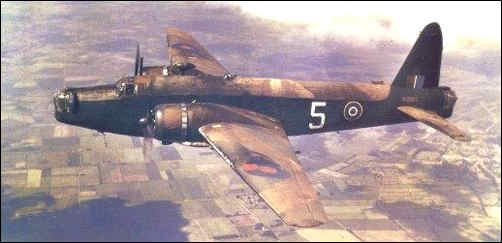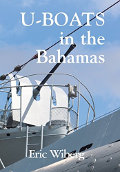Fighting the U-boats
Aircraft & Air forces
Vickers Wellington
prepared by Emmanuel Gustin

A Wellington Mk.IA, rather battered and without guns in its turrets
The Wellington was designed in the early 1930s, to meet specification B.9/32 for what was then called a "heavy" bomber. It used the geodetic construction method, developed by Barnes Wallis, in which the airframe was constructed as a metal network, and covered with fabric. This method had proven its value in the earlier Wellesley long-range bomber. The prototype made its first flight on 15 June 1936. Without nose and tail gun turrets, and with a different tailfin, the prototype looked very different from the production aircraft.
In October 1938 the first Wellingtons were delivered to No.9 Squadron. They had 1050hp Bristol Pegasus XVIII engines, Vickers gun turrets in the nose and tail, and a retractable Nash & Thompson belly turret. In 1939 deliveries of the Mk.IA began, which had powered Nash & Thompson turrets instead of the Vickers units. In the Mk.IC the belly turret was deleted, and two beam guns were installed. The Mk.II had 1145hp Rolls-Royce Merlin X engines, in anticipation of a shortage of Pegasus engines; but in reality there was a shortage of Merlins. The Mk.III had 1370hp Bristol Hercules III or XI engines, and had an usefully improved performance. The Mk.IV had Pratt & Whitney R-1830-S3C4G Twin Wasp engines.
The Mk.V and Mk.VI were high-altitude versions, equipped with a primitive pressure cabin, but their performance was disappointing, and they did not enter combat. The Mk.VII was cancelled, and the final bomber version was the Mk.X, with Hercules VI or XVI engines. The Mk.X also had a light alloy instead of a mild steel construction, so that the structure was stronger and lighter. The first Mk.X was delivered in July 1942.
Typically, the Wellington had a crew of five or six, including pilot, radio operator, navigator, and gunners. The wing had a single spar and two auxiliary spars, and was constructed in three sections. The upper and lower surfaces were geodetic panels. The fuselage was built up from panels with a geodetic construction, attached each other and to six main frames. The geodetic construction was very resistent to combat damage. The six fuel tanks held 750 imperial gallons; an extra 250 gallon tank could be carried in the bomb bay.
The RAF began the war with eight squadrons of Wellingtons. They participated in the first attacks of the war, including a disastous one on Wilhelmshaven, where 10 of the 24 Wellingtons were shot down and three damaged. The lesson was clear: The bombers were too vulnerable in daylight attacks, and Bomber Command switched to night operations. The Wellington, a better bomber than the Hampden and Blenheim, became the backbone of a continuously expanding bomber force. Of the 1034 aircraft that took off for operation Millenium, the 1000-aircraft attack on Cologne, more than half were Wellingtons. But the new four-engined heavy bombers gradually replaced them, and after the autumn of 1943 the Wellington was no longer used for the bombardments of Germany.
In the autumn of 1940 Wellingtons arrived in the Middle East, and in the spring of 1942 two squadrons were sent to the Far East. In the Mediterranean the Wellington was used as a bomber until the end of 1944. When the war ended, Wellingtons had flown 346,440 operational hours in Europe, and 525,769 hours in the Middle and Far East.
Initially the maritime roles of the Wellington were limited. Aside from attacks on Germany, Bomber Command undertook "gardening" operations: Minelaying off of the European coasts. As a rection to German minelaying efforts, the British created the Wellington DWI Mk.I, a very unusual modification of the Mk.I bomber. It was fitted with a ring 4.16m in diameter, and a generator to generate an electric current. The ring created a magnetic field, which made magnetic mines explode if the aircraft flew low over them.

A Wellington GR Mk.XIV.
Note open bomb bay doors, and radar radome under the nose.
In April 1942 the Wellington GR Mk.VIII entered service with No.172 squadron of Coastal Command. The GR.VIII was a modified Mk.IC bomber, with ASV Mk.II radar installed and in some cases also a Leigh Light. On 5 July, it sank its first U-boat, U-502. The next versions were the GR.XI, based on the Mk.X bomber with ASV Mk.II radar, and the GR.XII, which was similar to the GR.XI but carried a Leight Light. These three versions of the Wellington equipped 16 squadrons of Coastal Command.
The next versions were the GR.XIII and GR.XIV, both equipped with centimetric ASV Mk.III radar in a nose blister, and powered by Hercules XVII engines. The GR.XIII was a daylight version which could carry two 18-inch torpedoes, while the GR.XIV had a Leight Light for night operations, and rocket launching rails under the wings.
The last of 11461 Wellingtons was delivered on 25 October 1945. The Wellington had become the most built British bomber. In later years the Wellington was gradually retracted from frontline duties, and bombers and patrol aircraft were converted into transports and trainers. The last trainers were retired in 1953. Only two Wellingtons have survived to the present day.
U-boats sunk by this aircraft type (Wellington)
Specifications
| Version | B Mk.IC | B Mk.III | B Mk.X |
| Engines | 1000hp Bristol Pegasus XX | 1500hp Bristol Hercules IX | 1675hp Bristol Hercules XVI |
| Wing span | 26.26m | 26.26m | 26.26m |
| Length | 19.68m | 18.54m | 19.76m |
| Height | 5.31m | 5.31m | 5.33m |
| Wing Area | 78.04m2 | 78.04m2 | 78.0m2 |
| Empty Weight | 8417kg | 8417kg | 10194kg |
| Max. Weight | 12928kg | 13381kg | 16556kg |
| Max. Speed | 378km/h at 4725m | 410km/h at 3810m | 410km/h |
| Ceiling | 5490m | 5790m | 6700m |
| Range | 4100km with 454kg | 3540km with 680kg, 2475km with 2041kg | 3030km with 680kg |
| Armament | Two .303 guns in the front turret, four in the tail turret, and one in each beam position. | Two .303 guns in the front turret, four in the tail turret, and one in each beam position. | Two .303 guns in the front turret, four in the tail turret, and one in each beam position. |
| Bombs | 2041kg | 2041kg | 1814kg |
Sources
- Airplane Nr.140
- Jane's All the World's Aircraft, 1945 (collector's edition).


